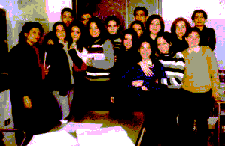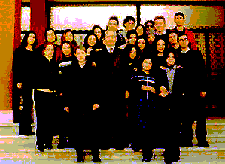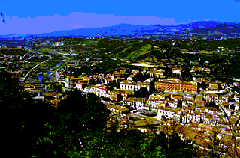 |
|
||
|
Partecipanti
al progetto Docenti :
Allievi :
Zona
studiata
COSENZA Situata a valle delle montagne della Sila. Il fiume Busento confluisce nel Crati a Cosenza e sfocia nel mare Ionio ad Est della Calabria. Caratteristiche dell’ambiente della zona studiata : zona con poca presenza industriale, a prevalenza attività artigianale. Approccio
disciplinare Biologia
: studio della
fauna, flora, rocce e sedimenti
L'activité de recherche se déroule bien, même si, pour le moment, elle est focalisée sur certains aspets du projet. En effets la partie concernant les analyses chimiques sur l'eau pourra être réalisée à partir du mois de septembre quand nous aurons reçu la valisette scientifique. Pendant cette période, nous sommes en train d'examiner deux aspects du sujet. Un groupe d'étudiants est en train d'analyser les aspects historiques concernants le fleuve Crati et en même temps un autre groupe est en train de réaliser une recherche concernant les aspects géographiques de la zone intéressée par le fleuve. A cet égard nous avons déjà réalisé un examen de la zone au bord du fleuve Crati et l'analyse concernant les différentes régions sauvages, agricoles, urbaines et industrielles a été indiquée sur des tableaux graphiques. Nous avons travaillé aussi pour localiser les points d'accès que nous utiliserons pour faire les analyses. A ce point du travail, nous avons dédié une attention particulière aux aspects historiques et litteraires du fleuve Crati et de ses tributaires comme le fleuve Busento à côté duquel le roi des Visigotes Alarique fut enterré. Quelques échantillons de pierres ont été prélevés aux points d'accés pour être analysés et classifiés en respectant les méthodes utilisées pendand nos séminaires de Liège pour mesurer la vitesse de l'eau et la profondeur du fleuve. En même temps les étudiants
ont été entraînés à réunir et à classifier les invertébrés. Enfin, les étudiants, supervisés par le professeur de sciences, sont en train d'étudier la section scientifique concernant la méthodologie qui sera utilisée pour identifier les invertébrés. A partir du moment où nous aurons la valisette scientifique, nous pourrons continuer notre recherche concernant les examens physiques et chimiques de l'eau. Franco Mollo
The work is examining two aspects of the problem. A group of students is taking care of the historical background of the River Crati; another group is devoting to its geographical exam. We have carried out a cartographic exam of the zone along which the River Crati flows, and the analysis concerning wild, agricultural, urban, and industrial regions have been indicated on graphic tables. In such a way we have managed to locate the access points to carry out the drawings. At this stage of our work, particular emphasis has been given to the historical and literary features of the River Crati, particularly to its tributaries such as the River Busento where the legend tells the Visigoth king Alaric was buried. Some rock samples have been drawn at the access points to be analysed and classified according to the methods applied during our seminaries in Liège to measure water-boosting and the depth of the river. At the same time students have been trained to collect and then to classify invertebrates. Another important aspect of our work has consisted in preparing a table of the data collected and draw a graphic, with a detailed comment. Finally, I have to underline
that our students, supervised by the Science teacher, are studying the
sections of science meant to identify the invertebrates.
|
|||
 .........
......... 



